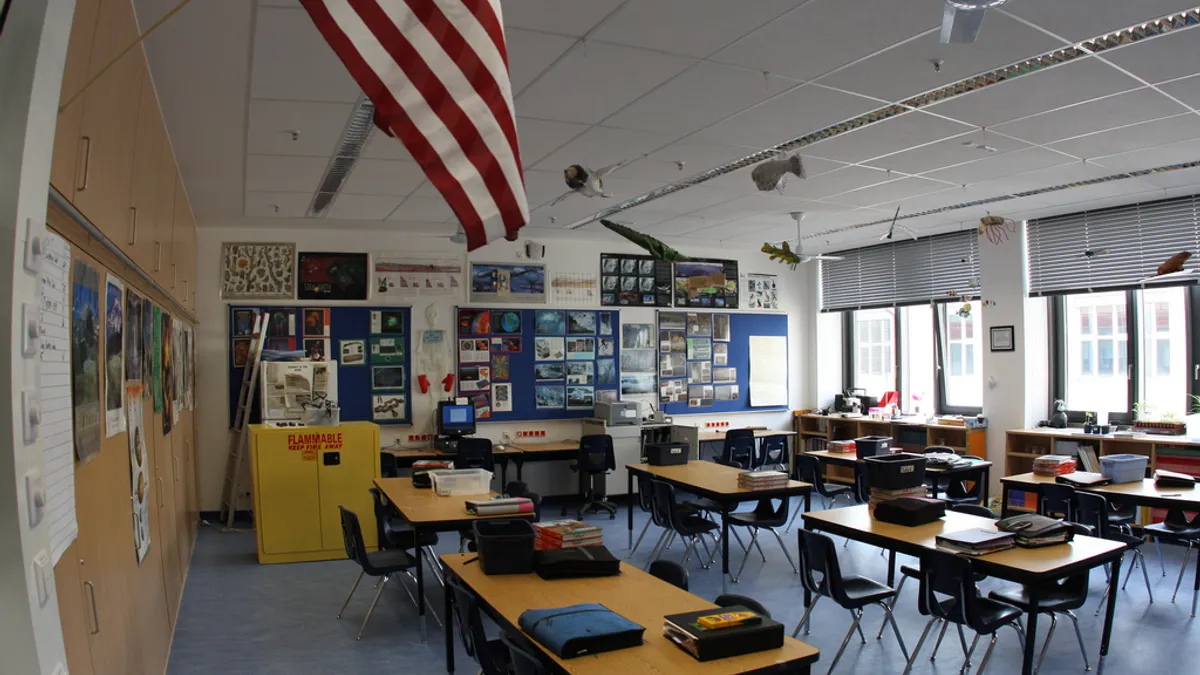Dive Brief:
- More than half of U.S. school districts have buildings in need of major repairs, according to estimates in a new report from the Government Accountability Office. For example, 41% of districts have problems with their heating, ventilation and air conditioning systems, which amounts to about 36,000 school buildings.
- The Centers for Disease Control and Prevention says operational ventilation systems are key to reopening buildings, and the GAO noted in a press release that its finding raises "fresh concerns about the safety of school facilities during the COVID-19 pandemic." The report also found high-poverty schools are more likely to rely on state funds for building repairs.
- The HEROES (Health and Economic Recovery Omnibus Emergency Solutions) Act — which passed the House but has not been voted on by the Senate — includes $915 billion in emergency funding for state and local governments, with around $100 billion marked specifically for K-12 schools and higher education institutions. That funding, however, cannot be used for capital projects.
Dive Insight:
The health and safety of school buildings will likely be scrutinized before classes begin in the fall. Jerry Roseman, environmental science director for the Philadelphia Federation of Teachers, points out many schools are already overcrowded, lack mechanical ventilation and are inadequately maintained. Though fresh air is recommended to reduce the spread of coronavirus, many schools don't have useable windows.
"Even before the COVID-19 pandemic, outdated and hazardous school buildings were undermining the quality of public education and putting students and educators at risk," said Rep. Bobby Scott (D-Virginia), chairman of the House Committee on Education and Labor, in a press release. "Now, the pandemic is exacerbating the consequences of our failure to make necessary investments in school infrastructure."
Prior to the pandemic, Scott had turned his attention back to the Rebuild America’s Schools Act. The legislation moved to the House floor after passing a committee vote last year and would give high-poverty schools $100 billion to improve the health and safety of facilities in addition to expanding internet connectivity.
A 2014 study by the National Center for Educational Statistics found 24% of schools across the country were in fair or poor condition, and more recent reports suggest school buildings pose serious health threats to students. Studies released in 2019 show lead-based paint is present in half of K-12 schools that were tested, and lead-contaminated drinking water was found in more than a third of buildings tested.
Beyond the coronavirus, aging buildings make for difficult learning conditions. Last fall, Memphis’ Kingsbury High School became too cold for students when a gas leak left the building with no heat during a cold snap. The high school’s heating and ventilation issues have already cost Shelby County Schools $70,000 in repairs. The state of aging buildings is forcing the district to consider consolidating students into one or two buildings to reduce the overall maintenance costs.
In today’s era’s of social distancing, however, squeezing more students into one building is likely not feasible, according to health and safety plans for the near future. Roseman pointed out many schools have “physical conditions that are already very limited and stressed,” such as buildings already serving students beyond capacity and inadequately cleaned facilities.
A 2016 report co-authored by the Center for Green Schools at the U.S. Green Building Council shows the United States would need to spend an additional $46 billion each year to maintain healthy and safe buildings.






 Dive Awards
Dive Awards








